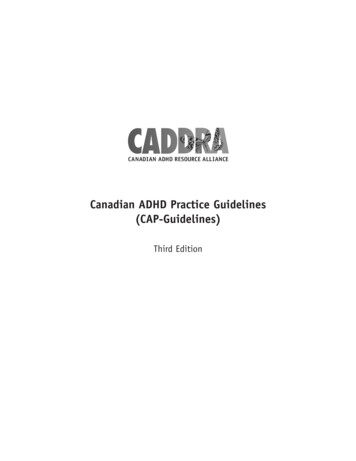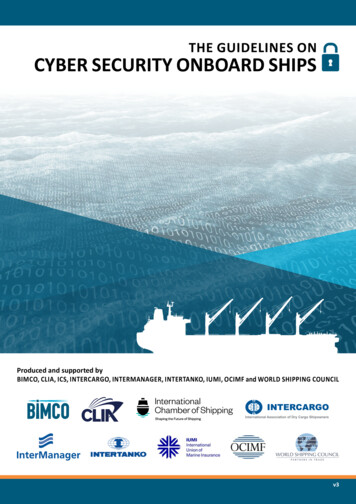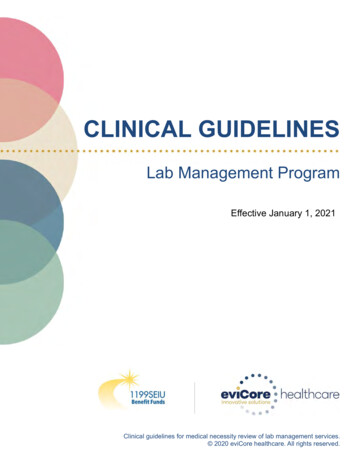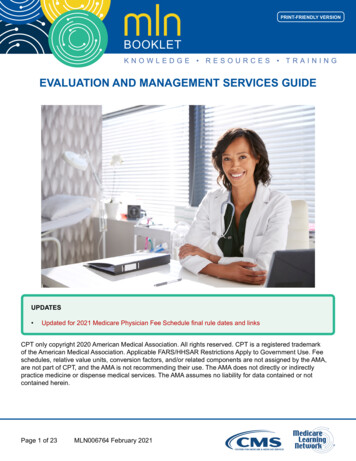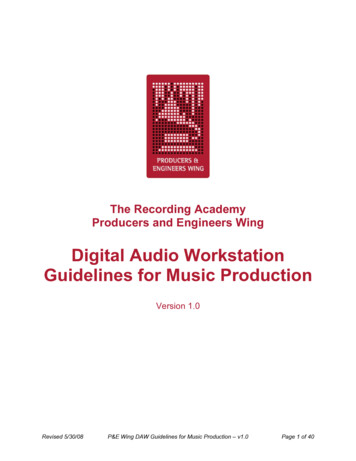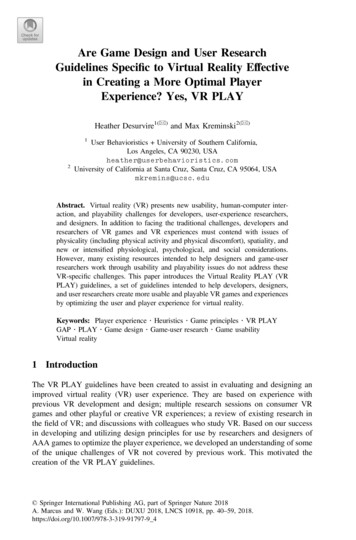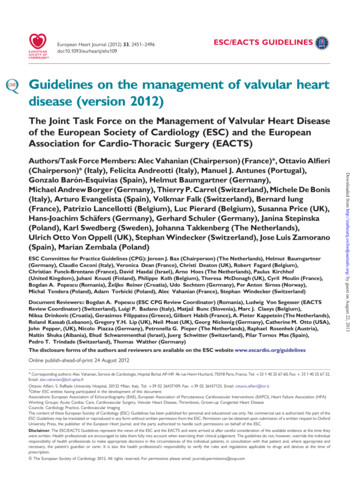
Transcription
European Heart Journal (2012) 33, 2451–2496doi:10.1093/eurheartj/ehs109ESC/EACTS GUIDELINESGuidelines on the management of valvular heartdisease (version 2012)The Joint Task Force on the Management of Valvular Heart Diseaseof the European Society of Cardiology (ESC) and the EuropeanAssociation for Cardio-Thoracic Surgery (EACTS)ESC Committee for Practice Guidelines (CPG): Jeroen J. Bax (Chairperson) (The Netherlands), Helmut Baumgartner(Germany), Claudio Ceconi (Italy), Veronica Dean (France), Christi Deaton (UK), Robert Fagard (Belgium),Christian Funck-Brentano (France), David Hasdai (Israel), Arno Hoes (The Netherlands), Paulus Kirchhof(United Kingdom), Juhani Knuuti (Finland), Philippe Kolh (Belgium), Theresa McDonagh (UK), Cyril Moulin (France),Bogdan A. Popescu (Romania), Željko Reiner (Croatia), Udo Sechtem (Germany), Per Anton Sirnes (Norway),Michal Tendera (Poland), Adam Torbicki (Poland), Alec Vahanian (France), Stephan Windecker (Switzerland)Document Reviewers:: Bogdan A. Popescu (ESC CPG Review Coordinator) (Romania), Ludwig Von Segesser (EACTSReview Coordinator) (Switzerland), Luigi P. Badano (Italy), Matjaž Bunc (Slovenia), Marc J. Claeys (Belgium),Niksa Drinkovic (Croatia), Gerasimos Filippatos (Greece), Gilbert Habib (France), A. Pieter Kappetein (The Netherlands),Roland Kassab (Lebanon), Gregory Y.H. Lip (UK), Neil Moat (UK), Georg Nickenig (Germany), Catherine M. Otto (USA),John Pepper, (UK), Nicolo Piazza (Germany), Petronella G. Pieper (The Netherlands), Raphael Rosenhek (Austria),Naltin Shuka (Albania), Ehud Schwammenthal (Israel), Juerg Schwitter (Switzerland), Pilar Tornos Mas (Spain),Pedro T. Trindade (Switzerland), Thomas Walther (Germany)The disclosure forms of the authors and reviewers are available on the ESC website www.escardio.org/guidelinesOnline publish-ahead-of-print 24 August 2012* Corresponding authors: Alec Vahanian, Service de Cardiologie, Hopital Bichat AP-HP, 46 rue Henri Huchard, 75018 Paris, France. Tel: 33 1 40 25 67 60; Fax: 33 1 40 25 67 32.Email: alec.vahanian@bch.aphp.frOttavio Alfieri, S. Raffaele University Hospital, 20132 Milan, Italy. Tel: 39 02 26437109; Fax: 39 02 26437125. Email: ottavio.alfieri@hsr.it†Other ESC entities having participated in the development of this document:Associations: European Association of Echocardiography (EAE), European Association of Percutaneous Cardiovascular Interventions (EAPCI), Heart Failure Association (HFA)Working Groups: Acute Cardiac Care, Cardiovascular Surgery, Valvular Heart Disease, Thrombosis, Grown-up Congenital Heart DiseaseCouncils: Cardiology Practice, Cardiovascular ImagingThe content of these European Society of Cardiology (ESC) Guidelines has been published for personal and educational use only. No commercial use is authorized. No part of theESC Guidelines may be translated or reproduced in any form without written permission from the ESC. Permission can be obtained upon submission of a written request to OxfordUniversity Press, the publisher of the European Heart Journal, and the party authorized to handle such permissions on behalf of the ESC.Disclaimer. The ESC/EACTS Guidelines represent the views of the ESC and the EACTS and were arrived at after careful consideration of the available evidence at the time theywere written. Health professionals are encouraged to take them fully into account when exercising their clinical judgement. The guidelines do not, however, override the individualresponsibility of health professionals to make appropriate decisions in the circumstances of the individual patients, in consultation with that patient and, where appropriate andnecessary, the patient’s guardian or carer. It is also the health professional’s responsibility to verify the rules and regulations applicable to drugs and devices at the time ofprescription.& The European Society of Cardiology 2012. All rights reserved. For permissions please email: journals.permissions@oup.comDownloaded from http://eurheartj.oxfordjournals.org/ by guest on August 22, 2013Authors/Task Force Members: Alec Vahanian (Chairperson) (France)*, Ottavio Alfieri(Chairperson)* (Italy), Felicita Andreotti (Italy), Manuel J. Antunes (Portugal),Gonzalo Barón-Esquivias (Spain), Helmut Baumgartner (Germany),Michael Andrew Borger (Germany), Thierry P. Carrel (Switzerland), Michele De Bonis(Italy), Arturo Evangelista (Spain), Volkmar Falk (Switzerland), Bernard Iung(France), Patrizio Lancellotti (Belgium), Luc Pierard (Belgium), Susanna Price (UK),Hans-Joachim Schäfers (Germany), Gerhard Schuler (Germany), Janina Stepinska(Poland), Karl Swedberg (Sweden), Johanna Takkenberg (The Netherlands),Ulrich Otto Von Oppell (UK), Stephan Windecker (Switzerland), Jose Luis Zamorano(Spain), Marian Zembala (Poland)
2452ESC/EACTS Guidelines- - - - - - - - - - - - - - - - - - - - - - - - - - - - - - - - - - - - - - - - - - - - - - - - - - - - - - - - - - - - - - - - - - - - - - - - - - -- - - - - - - - - - - - - - - - - - - - - - - - - - - - - - - - - - - - - - - - - - - - - - - - - - - - - - - - - - - - - - - - - - - - - - - - - - KeywordsValve disease † Valve surgery † Percutaneous valve intervention † Aortic stenosis † Mitral regurgitationTable of Contents. . .2453. . .2453. . .2468.2469.2469.2469.2470.24706.1.3. Results of surgery . . . . . . . . . . . . . . . . . . . . .6.1.4. Percutaneous intervention . . . . . . . . . . . . . . . .6.1.5. Indications for intervention . . . . . . . . . . . . . . .6.1.6. Medical therapy . . . . . . . . . . . . . . . . . . . . . . .6.1.7. Serial testing . . . . . . . . . . . . . . . . . . . . . . . . .6.2. Secondary mitral regurgitation . . . . . . . . . . . . . . . .6.2.1. Evaluation . . . . . . . . . . . . . . . . . . . . . . . . . . .6.2.2. Natural history . . . . . . . . . . . . . . . . . . . . . . .6.2.3. Results of surgery . . . . . . . . . . . . . . . . . . . . .6.2.4. Percutaneous intervention . . . . . . . . . . . . . . . .6.2.5. Indications for intervention . . . . . . . . . . . . . . .6.2.6. Medical treatment . . . . . . . . . . . . . . . . . . . . .7. Mitral stenosis . . . . . . . . . . . . . . . . . . . . . . . . . . . . . .7.1. Evaluation . . . . . . . . . . . . . . . . . . . . . . . . . . . . .7.2. Natural history . . . . . . . . . . . . . . . . . . . . . . . . . .7.3. Results of intervention . . . . . . . . . . . . . . . . . . . . .7.3.1. Percutaneous mitral commissurotomy . . . . . . . .7.3.2. Surgery . . . . . . . . . . . . . . . . . . . . . . . . . . . .7.4. Indications for intervention . . . . . . . . . . . . . . . . . .7.5. Medical therapy . . . . . . . . . . . . . . . . . . . . . . . . . .7.6. Serial testing . . . . . . . . . . . . . . . . . . . . . . . . . . . .7.7. Special patient populations . . . . . . . . . . . . . . . . . .8. Tricuspid regurgitation . . . . . . . . . . . . . . . . . . . . . . . . .8.1. Evaluation . . . . . . . . . . . . . . . . . . . . . . . . . . . . .8.2. Natural history . . . . . . . . . . . . . . . . . . . . . . . . . .8.3. Results of surgery . . . . . . . . . . . . . . . . . . . . . . . .8.4. Indications for surgery . . . . . . . . . . . . . . . . . . . . .8.5. Medical therapy . . . . . . . . . . . . . . . . . . . . . . . . . .9. Tricuspid stenosis . . . . . . . . . . . . . . . . . . . . . . . . . . . .9.1. Evaluation . . . . . . . . . . . . . . . . . . . . . . . . . . . . .9.2. Surgery . . . . . . . . . . . . . . . . . . . . . . . . . . . . . . .9.3. Percutaneous intervention . . . . . . . . . . . . . . . . . . .9.4. Indications for intervention . . . . . . . . . . . . . . . . . .9.5. Medical therapy . . . . . . . . . . . . . . . . . . . . . . . . . .10. Combined and multiple valve diseases . . . . . . . . . . . . . .11. Prosthetic valves . . . . . . . . . . . . . . . . . . . . . . . . . . . .11.1. Choice of prosthetic valve . . . . . . . . . . . . . . . . . .11.2. Management after valve replacement . . . . . . . . . . .11.2.1. Baseline assessment and modalities of follow-up11.2.2. Antithrombotic management . . . . . . . . . . . . .11.2.2.1. General management . . . . . . . . . . . . . . .11.2.2.2. Target INR . . . . . . . . . . . . . . . . . . . . . .11.2.2.3. Management of overdose of vitamin Kantagonists and bleeding . . . . . . . . . . . . . . . . . . .11.2.2.4. Combination of oral anticoagulants withantiplatelet drugs . . . . . . . . . . . . . . . . . . . . . . . .11.2.2.5. Interruption of anticoagulant therapy . . . .11.2.3. Management of valve thrombosis . . . . . . . . . .11.2.4. Management of thromboembolism . . . . . . . . .11.2.5. Management of haemolysis and paravalvular aded from http://eurheartj.oxfordjournals.org/ by guest on August 22, 2013Abbreviations and acronyms . . . . . . . . . . . . . . . . . . . . .1. Preamble . . . . . . . . . . . . . . . . . . . . . . . . . . . . . . . .2. Introduction . . . . . . . . . . . . . . . . . . . . . . . . . . . . . .2.1. Why do we need new guidelines on valvular heartdisease? . . . . . . . . . . . . . . . . . . . . . . . . . . . . . . . .2.2. Contents of these guidelines . . . . . . . . . . . . . . .2.3. How to use these guidelines . . . . . . . . . . . . . . .3. General comments . . . . . . . . . . . . . . . . . . . . . . . . .3.1. Patient evaluation . . . . . . . . . . . . . . . . . . . . . .3.1.1. Clinical evaluation . . . . . . . . . . . . . . . . . . .3.1.2. Echocardiography . . . . . . . . . . . . . . . . . . .3.1.3. Other non-invasive investigations . . . . . . . . .3.1.3.1. Stress testing . . . . . . . . . . . . . . . . . . .3.1.3.2. Cardiac magnetic resonance . . . . . . . . .3.1.3.3. Computed tomography . . . . . . . . . . . .3.1.3.4. Fluoroscopy . . . . . . . . . . . . . . . . . . . .3.1.3.5. Radionuclide angiography . . . . . . . . . . .3.1.3.6. Biomarkers . . . . . . . . . . . . . . . . . . . .3.1.4. Invasive investigations . . . . . . . . . . . . . . . . .3.1.5. Assessment of comorbidity . . . . . . . . . . . . .3.2. Endocarditis prophylaxis . . . . . . . . . . . . . . . . . .3.3. Prophylaxis for rheumatic fever . . . . . . . . . . . . .3.4. Risk stratification . . . . . . . . . . . . . . . . . . . . . . .3.5. Management of associated conditions . . . . . . . . .3.5.1. Coronary artery disease . . . . . . . . . . . . . . .3.5.2. Arrhythmias . . . . . . . . . . . . . . . . . . . . . . .4. Aortic regurgitation . . . . . . . . . . . . . . . . . . . . . . . . .4.1. Evaluation . . . . . . . . . . . . . . . . . . . . . . . . . . .4.2. Natural history . . . . . . . . . . . . . . . . . . . . . . . .4.3. Results of surgery . . . . . . . . . . . . . . . . . . . . . .4.4. Indications for surgery . . . . . . . . . . . . . . . . . . .4.5. Medical therapy . . . . . . . . . . . . . . . . . . . . . . . .4.6. Serial testing . . . . . . . . . . . . . . . . . . . . . . . . . .4.7. Special patient populations . . . . . . . . . . . . . . . .5. Aortic stenosis . . . . . . . . . . . . . . . . . . . . . . . . . . . .5.1. Evaluation . . . . . . . . . . . . . . . . . . . . . . . . . . .5.2. Natural history . . . . . . . . . . . . . . . . . . . . . . . .5.3. Results of intervention . . . . . . . . . . . . . . . . . . .5.4. Indications for intervention . . . . . . . . . . . . . . . .5.4.1. Indications for aortic valve replacement . . . . .5.4.2. Indications for balloon valvuloplasty . . . . . . .5.4.3. Indications for transcatheter aortic valveimplantation . . . . . . . . . . . . . . . . . . . . . . . . . . .5.5. Medical therapy . . . . . . . . . . . . . . . . . . . . . . . .5.6. Serial testing . . . . . . . . . . . . . . . . . . . . . . . . . .5.7. Special patient populations . . . . . . . . . . . . . . . .6. Mitral regurgitation . . . . . . . . . . . . . . . . . . . . . . . . .6.1. Primary mitral regurgitation . . . . . . . . . . . . . . . .6.1.1. Evaluation . . . . . . . . . . . . . . . . . . . . . . . . .6.1.2. Natural history . . . . . . . . . . . . . . . . . . . . .
2453ESC/EACTS Guidelines11.2.6. Management of bioprosthetic failure11.2.7. Heart failure . . . . . . . . . . . . . . . .12. Management during non-cardiac surgery . . . .12.1. Preoperative evaluation . . . . . . . . . . . .12.2. Specific valve lesions . . . . . . . . . . . . . .12.2.1. Aortic stenosis . . . . . . . . . . . . . .12.2.2. Mitral stenosis . . . . . . . . . . . . . . .12.2.3. Aortic and mitral regurgitation . . . .12.2.4. Prosthetic valves . . . . . . . . . . . . .12.3. Perioperative monitoring . . . . . . . . . . .13. Management during pregnancy . . . . . . . . . . .13.1. Native valve disease . . . . . . . . . . . . . .13.2. Prosthetic valves . . . . . . . . . . . . . . . .References . . . . . . . . . . . . . . . . . . . . . . . . . . .2489.2489.2489.2489Abbreviations and acronymsangiotensin-converting enzymeatrial fibrillationactivated partial thromboplastin timeaortic regurgitationangiotensin receptor blockersaortic stenosisaortic valve replacementB-type natriuretic peptidebody surface areacoronary artery bypass graftingcoronary artery diseasecardiac magnetic resonanceCommittee for Practice Guidelinescardiac resynchronization therapycomputed tomographyEuropean Association for Cardio-Thoracic Surgeryelectrocardiogramejection fractioneffective regurgitant orifice areaEuropean Society of Cardiology(Endovascular Valve Edge-to-Edge REpair STudy)heart failureinternational normalized ratioleft atriallow molecular weight heparinleft ventricularleft ventricular ejection fractionleft ventricular end-diastolic diameterleft ventricular end-systolic diametermitral regurgitationmitral stenosismulti-slice computed tomographyNew York Heart Associationproximal isovelocity surface areapercutaneous mitral commissurotomyparavalvular leakright ventricularrecombinant tissue plasminogen activatorstructural valve deteriorationSociety of Thoracic Surgeonstricuspid annular plane systolic excursiontranscatheter aortic valve implantationtransoesophageal echocardiographytricuspid regurgitationtricuspid stenosistransthoracic echocardiographyunfractionated heparinvalvular heart diseasethree-dimensional echocardiography1. PreambleGuidelines summarize and evaluate all evidence available, at thetime of the writing process, on a particular issue with the aim ofassisting physicians in selecting the best management strategiesfor an individual patient with a given condition, taking intoaccount the impact on outcome, as well as the risk-benefit-ratioof particular diagnostic or therapeutic means. Guidelines are notsubstitutes for-, but complements to, textbooks and cover theESC Core Curriculum topics. Guidelines and recommendationsshould help physicians to make decisions in their daily practice.However, the final decisions concerning an individual patientmust be made by the responsible physician(s).A great number of guidelines have been issued in recentyears by the European Society of Cardiology (ESC) as well asby other societies and organisations. Because of their impacton clinical practice, quality criteria for the development ofguidelines have been established, in order to make all decisionstransparent to the user. The recommendations for formulatingand issuing ESC Guidelines can be found on the ESC web c-guidelines/about/Pages/rules-writing.aspx). ESC Guidelines represent the officialposition of the ESC on a given topic and are regularly updated.Members of this Task Force were selected by the ESC and European Association for Cardio-Thoracic Surgery (EACTS) to represent professionals involved with the medical care of patients withthis pathology. Selected experts in the field undertook a comprehensive review of the published evidence for diagnosis, management and/or prevention of a given condition, according to ESCCommittee for Practice Guidelines (CPG) and EACTS policy.A critical evaluation of diagnostic and therapeutic procedureswas performed, including assessment of the risk –benefit ratio. Estimates of expected health outcomes for larger populations wereincluded, where data exist. The levels of evidence and the strengthsof recommendation of particular treatment options were weighedand graded according to predefined scales, as outlined in Tables 1and 2.The experts of the writing and reviewing panels filled in Declarations of Interest forms dealing with activities which might be perceived as real or potential sources of conflicts of interest. Theseforms were compiled into one file and can be found on the ESCweb site (http://www.escardio.org/guidelines). Any changes indeclarations of interest that arise during the writing period mustbe notified to the ESC and EACTS and updated. The Task ForceDownloaded from http://eurheartj.oxfordjournals.org/ by guest on August 22, EUFHVHD3DE
2454ESC/EACTS GuidelinesTable 1Classes of recommendationsClasses ofrecommendationsClass IEvidence and/or general agreementthat a given treatment or procedureis beneficial, useful, effective.Class IIConflicting evidence and/or adivergence of opinion about theusefulness/efficacy of the giventreatment or procedure.Suggested wording to useIs recommended/isindicatedWeight of evidence/opinion is infavour of usefulness/efficacy.Should be consideredClass IIbUsefulness/efficacy is less wellestablished by evidence/opinion.May be consideredEvidence or general agreement thatthe given treatment or procedureis not useful/effective, and in somecases may be harmful.Is not recommendedLevels of evidenceLevel ofevidence AData derived from multiple randomizedclinical trials or meta-analyses.Level ofevidence BData derived from a single randomizedclinical trial or large non-randomizedstudies.Level ofevidence CConsensus of opinion of the experts and/or small studies, retrospective studies,registries.received its entire financial support from the ESC and EACTS,without any involvement from the healthcare industry.The ESC CPG, in collaboration with the Clinical GuidelinesCommittee of EACTS, supervises and co-ordinates the preparationof these new Guidelines. The Committees are also responsible forthe endorsement process of these Guidelines. The ESC/EACTSGuidelines undergo extensive review by the CPG, the ClinicalGuidelines Committee of EACTS and external experts. After appropriate revisions, it is approved by all the experts involved inthe Task Force. The finalized document is approved by the CPGfor publication in the European Heart Journal and the EuropeanJournal of Cardio-Thoracic Surgery.After publication, dissemination of the message is of paramountimportance. Pocket-sized versions and personal digital assistant(PDA) downloadable versions are useful at the point of care.Some surveys have shown that the intended end-users are sometimes unaware of the existence of guidelines, or simply do nottranslate them into practice, so this is why implementation programmes for new guidelines form an important component ofthe dissemination of knowledge. Meetings are organized by theESC and EACTS and directed towards their member National Societies and key opinion-leaders in Europe. Implementation meetings can also be undertaken at national levels, once theguidelines have been endorsed by the ESC and EACTS membersocieties and translated into the national language. Implementationprogrammes are needed because it has been shown that theoutcome of disease may be favourably influenced by the thoroughapplication of clinical recommendations.Thus the task of writing these Guidelines covers not only theintegration of the most recent research, but also the creation ofeducational tools and implementation programmes for the recommendations. The loop between clinical research, writing of guidelines and implementing them into clinical practice can only thenbe completed if surveys and registries are performed to verifythat real-life daily practice is in keeping with what is recommendedin the guidelines. Such surveys and registries also make it possible toevaluate the impact of implementation of the guidelines on patientoutcomes. The guidelines do not, however, override the individualresponsibility of health professionals to make appropriate decisionsin the circumstances of the individual patient, in consultation withthat patient and—where appropriate and necessary—the patient’sguardian or carer. It is also the health professional’s responsibilityto verify the rules and regulations applicable to drugs and devicesat the time of prescription.2. Introduction2.1 Why do we need new guidelineson valvular heart disease?Although valvular heart disease (VHD) is less common in industrialized countries than coronary artery disease (CAD), heart failureDownloaded from http://eurheartj.oxfordjournals.org/ by guest on August 22, 2013Class IIaClass IIITable 2Definition
2455ESC/EACTS Guidelines† Firstly, new evidence was accumulated, particularly on riskstratification; in addition, diagnostic methods—in particularechocardiography—and therapeutic options have changed dueto further development of surgical valve repair and the introduction of percutaneous interventional techniques, mainly transcatheter aortic valve implantation (TAVI) and percutaneousedge-to-edge valve repair. These changes are mainly relatedto patients with aortic stenosis (AS) and mitral regurgitation(MR).† Secondly, the importance of a collaborative approach betweencardiologists and cardiac surgeons in the management ofpatients with VHD—in particular when they are at increasedperioperative risk—has led to the production of a joint document by the ESC and EACTS. It is expected that this jointeffort will provide a more global view and thereafter facilitateimplementation of these guidelines in both communities.2.2 Contents of these guidelinesThese guidelines focus on acquired VHD, are oriented towardsmanagement, and do not deal with endocarditis or congenitalvalve disease, including pulmonary valve disease, since recentguidelines have been produced by the ESC on these topics.10,11Finally, these guidelines are not intended to include detailed information covered in ESC Guidelines on other topics, the ESC Association/Working Group’s recommendations, position statementsand expert consensus papers and the specific sections of theESC Textbook of Cardiovascular Medicine.122.3 How to use these guidelinesThe Committee emphasizes that many factors ultimately determine the most appropriate treatment in individual patients withina given community. These factors include availability of diagnosticequipment, the expertise of cardiologists and surgeons—especiallyin the field of valve repair and percutaneous intervention—and,notably, the wishes of well-informed patients. Furthermore, dueto the lack of evidence-based data in the field of VHD, mostrecommendations are largely the result of expert consensusopinion. Therefore, deviations from these guidelines may be appropriate in certain clinical circumstances.3. General commentsThe aims of the evaluation of patients with VHD are to diagnose,quantify and assess the mechanism of VHD, as well as its consequences. The consistency between the results of diagnostic investigations and clinical findings should be checked at each step in thedecision-making process. Decision-making should ideally be madeby a ‘heart team’ with a particular expertise in VHD, including cardiologists, cardiac surgeons, imaging specialists, anaesthetists and, ifneeded, general practitioners, geriatricians, or intensive care specialists. This ‘heart team’ approach is particularly advisable in themanagement of high-risk patients and is also important for othersubsets, such as asymptomatic patients, where the evaluation ofvalve repairability is a key component in decision-making.Decision-making can be summarized according to the approachdescribed in Table 3.Finally, indications for intervention—and which type of intervention should be chosen—rely mainly on the comparative assessment of spontaneous prognosis and the results of interventionaccording to the characteristics of VHD and comorbidities.Table 3 Essential questions in the evaluation of apatient for valvular intervention Is valvular heart disease severe? Does the patient have symptoms? Are symptoms related to valvular disease? What are patient life expectancya and expected quality of life? Do the expected benefits of intervention (vs. spontaneous outcome)outweigh its risks? What are the patient's wishes? Are local resources optimal for planned intervention?aLife expectancy should be estimated according to age, gender, comorbidities andcountry-specific life expectancy.3.1 Patient evaluation3.1.1 Clinical evaluationThe aim of obtaining a case history is to assess symptoms and toevaluate for associated comorbidity. The patient is questioned onhis/her lifestyle to detect progressive changes in daily activity inorder to limit the subjectivity of symptom analysis, particularly inthe elderly. In chronic conditions, adaptation to symptomsoccurs: this also needs to be taken into consideration. Symptomdevelopment is often a driving indication for intervention. Patientswho currently deny symptoms, but have been treated for HF,should be classified as symptomatic. The reason for—and degreeof—functional limitation should be documented in the records.In the presence of comorbidities it is important to consider thecause of the symptoms.Downloaded from http://eurheartj.oxfordjournals.org/ by guest on August 22, 2013(HF), or hypertension, guidelines are of interest in this fieldbecause VHD is frequent and often requires intervention.1,2Decision-making for intervention is complex, since VHD is oftenseen at an older age and, as a consequence, there is a higher frequency of comorbidity, contributing to increased risk of intervention.1,2 Another important aspect of contemporary VHD is thegrowing proportion of previously-operated patients who presentwith further problems.1 Conversely, rheumatic valve disease stillremains a major public health problem in developing countries,where it predominantly affects young adults.3When compared with other heart diseases, there are few trialsin the field of VHD and randomized clinical trials are particularlyscarce.Finally, data from the Euro Heart Survey on VHD,4,5 confirmedby other clinical trials, show that there is a real gap between theexisting guidelines and their effective application.6 – 9We felt that an update of the existing ESC guidelines,8 publishedin 2007, was necessary for two main reasons:
24563.1.2 EchocardiographyEchocardiography is the key technique used to confirm the diagnosis of VHD, as well as to assess its severity and prognosis. It shouldbe performed and interpreted by properly trained personnel.14 It isindicated in any patient with a murmur, unless no suspicion of valvedisease is raised after the clinical evaluation.The evaluation of the severity of stenotic VHD should combinethe assessment of valve area with flow-dependent indices such asmean pressure gradient and maximal flow velocity (Table 4).15Flow-dependent indices add further information and have aprognostic value.The assessment of valvular regurgitation should combine differentindices including quantitative measurements, such as the vena contractaand effective regurgitant orifice area (EROA), which is less dependenton flow conditions than colour Doppler jet size (Table 5).16,17However, all quantitative evaluations have limitations. In particular,they combine a number of measurements and are highly sensitive toerrors of measurement, and are highly operator-dependent; therefore, their use requires experience and integration of a number ofmeasurements, rather than reliance on a single parameter.Thus, when assessing the severity of VHD, it is necessary to checkconsistency between the different echocardiographic measurements, as well as the anatomy and mechanisms of VHD. It is alsonecessary to check their consistency with the clinical assessment.Echocardiography should include a comprehensive evaluation ofall valves, looking for associated valve diseases, and the aorta.Indices of left ventricular (LV) enlargement and function arestrong prognostic factors. While diameters allow a less completeassessment of LV size than volumes, their prognostic value hasbeen studied more extensively. LV dimensions should be indexedto body surface area (BSA). The use of indexed values is of particular interest in patients with a small body size but should be avoidedin patients with severe obesity (body mass index .40 kg/m2).Indices derived from Doppler tissue imaging and strain assessmentsseem to be of potential interest for the detection of early impairment of LV function but lack validation of their prognostic value forclinical endpoints.Table 4 Echocardiographic criteria for the definitionof severe valve stenosis: an integrative approachValve area s 1.0 1.0–––Indexed valve area (cm²/m² BSA) 0.6Mean gradient (mmHg) 40aaMaximum jet velocity (m/s) 4.0Velocity ratio 0.25 10b 5––––BSA ¼ body surface area.aIn patients with normal cardiac output/transvalvular flow.bUseful in patients in sinus rhythm, to be interpreted according to heart rate.Adapted from Baumgartner et al. 15Finally, the pulmonary pressures should be evaluated, as well asrig
Working Groups: Acute Cardiac Care, Cardiovascular Surgery, Valvular Heart Disease, Thrombosis, Grown-up Congenital Heart Disease Councils: Cardiology Practice, Cardiovascular Imaging The content of these European Society of Cardiology (ESC) Guidelines has been published for personal and educational use only.





